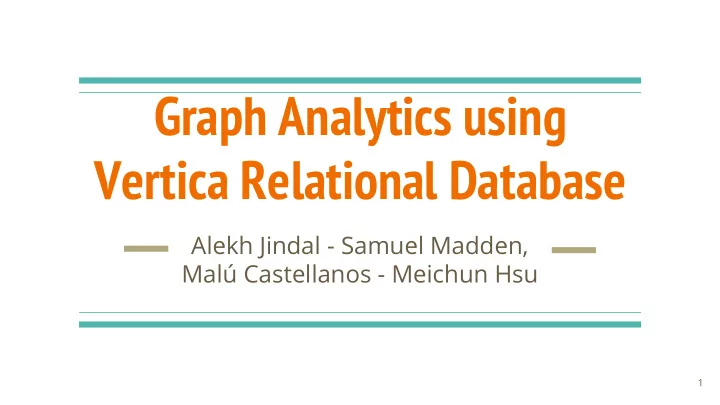

Graph Analytics using Vertica Relational Database Alekh Jindal - Samuel Madden, Malú Castellanos - Meichun Hsu 1
Introduction High demand for graph analytics ● Popularity of distributed graph computing systems ● Vertex-centric systems: Pregel, Giraph, GraphLab ○ Question: ● Are traditional relational database systems not good enough for graph analytics? 2
Introduction Limitations of distributed graph computing systems: Data is initially collected and stored in a relational database ● Graph processing is slow for very large graphs ● Users have to choose a subgraph to run the algorithm ○ Preparation might include operations that relational databases are ● optimized for. Pre-processing or post-processing ○ Some graph algorithms compute aggregates over a large ● neighbourhood Hard to express in vertex-centric systems ○ 3
Goal Show how vertex-centric graph processing can be translated, ● optimized and run on Vertica ○ SSSP, PageRank, Connected Components Compare Performance with two vertex-centric distributed systems ● for graph analysis ( Giraph and GraphLab ) Vertica → Enterprise column-store database management system ● Supports parallel processing ○ 4
Vertex-Centric Model The user provides a vertex.compute function (UDF): ● The UDF will be executed at each node. ○ Will update the node’s state. ○ And communicate the changes to the neighbours. ○ 5
Giraph Physical Plan 1. Input Superstep: Workers reading the data, building “Server Data stores” 2. Intermediate step: Run UDF, shuffle messages, wait for everyone, synchronize. 3. Output Superstep: Produce the output. 6
Giraph Logical Plan Same query plan but in relational logic: 1. V join E 2. (V join E) join M: messages from previous superstep 3. Run UDF 4. Produce new state for vertex (V’) and messages for the next superstep (M’). 7
Overview ● Translation to SQL queries ● Query Optimization ● Query Execution ● Extending Vertica 8
Translation to SQL 1) Eliminate the message table 9
Translation to SQL 2) Translate vertex compute function Logical plan 10
Query Optimizations 1) Update Vs. Replace 11
Query Optimizations 2) Incremental Evaluation 12
Query Optimizations 2) Join Elimination Join Elimination in PageRank 13
Query Execution Physical Design ● Encoding and compression, sort orders, multiple table projections ○ Join Optimization ● Join directly over compressed data, choose from hash join and merge join ○ Query Pipelining ● Avoids materializing intermediate output and repeated access to disk ○ Intra-query Parallelism ● Process subgraphs in parallel across cpu cores using GroupBy ○ 14
Query Execution Plan of SSSP Different from Giraph execution pipeline: 1. Filter unnecessary tuples as early as possible. 2. Fully pipelines the execution flow. 3. Picks the best join execution strategy. 15
Extending Vertica Running unmodified vertex programs ● As table UDFs without translating to relational operators ○ 16
Extending Vertica Avoiding Intermediate Disk I/O ● Load and store graph in shared memory, higher memory footprint ○ 17
Experiments Setup : Cluster of 4 machines ● 48 GB memory ● 1.4 TB Disk ● Dataset: 18
Experiments Data Preparation: Runtime: 19
Experiments Memory Usage (PageRank): 20
Experiments In memory Graph Analysis: 21
Experiments Mixed Graph and Relational Analysis : More Complicated Graph Processing: 22
Conclusion Vertica can be tuned to offer good end-to-end performance on graph ● queries (because it is optimized for scans, joins and aggregates). Users can trade memory with reduced I/O cost in iterative graph analysis. ● Relational databases can combine graph processing with relational ● analysis as pre-processing or post-processing steps. Features of relational databases can be combined with graph processing ● systems and it might be a good idea to stitch these systems together. 23
Thank you for your attention. 24
Recommend
More recommend